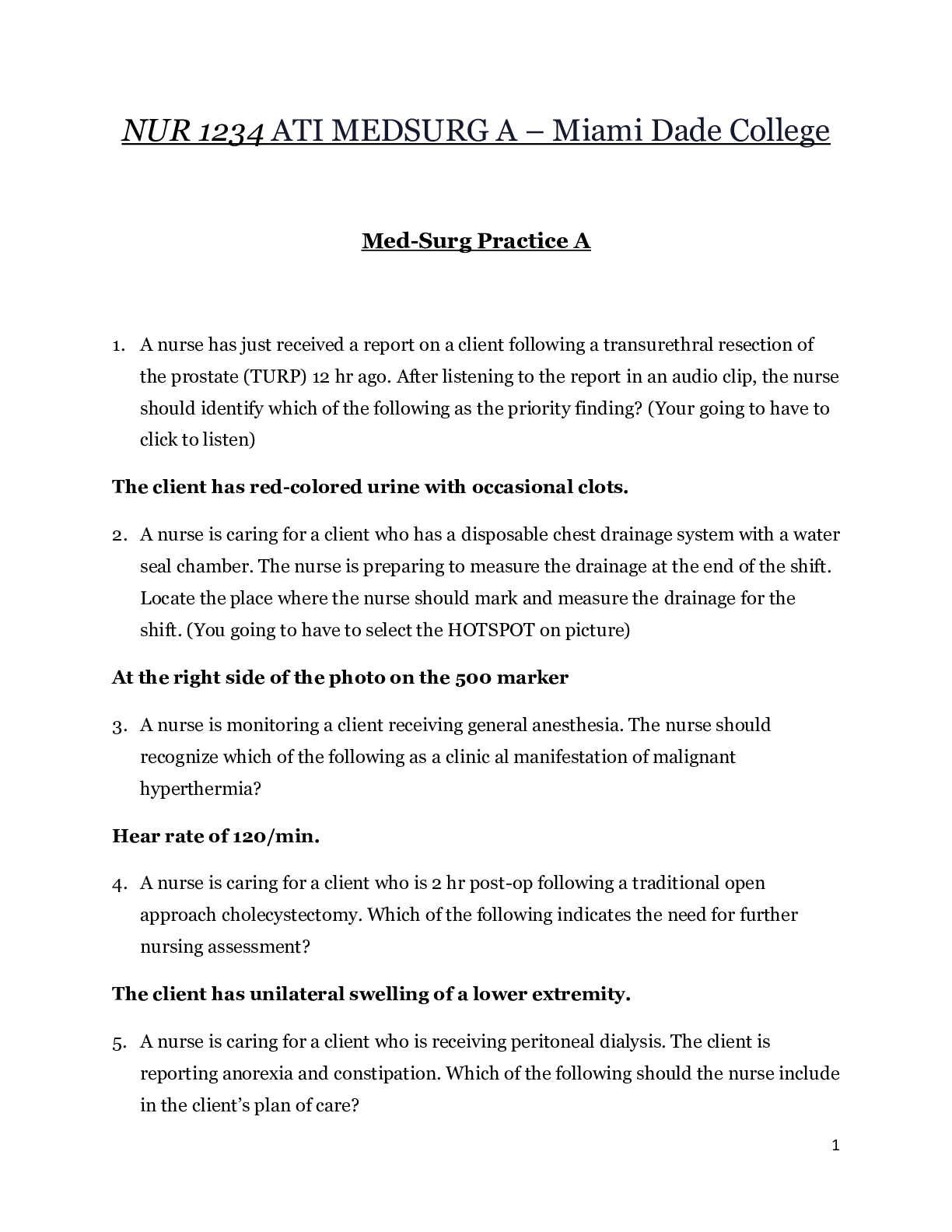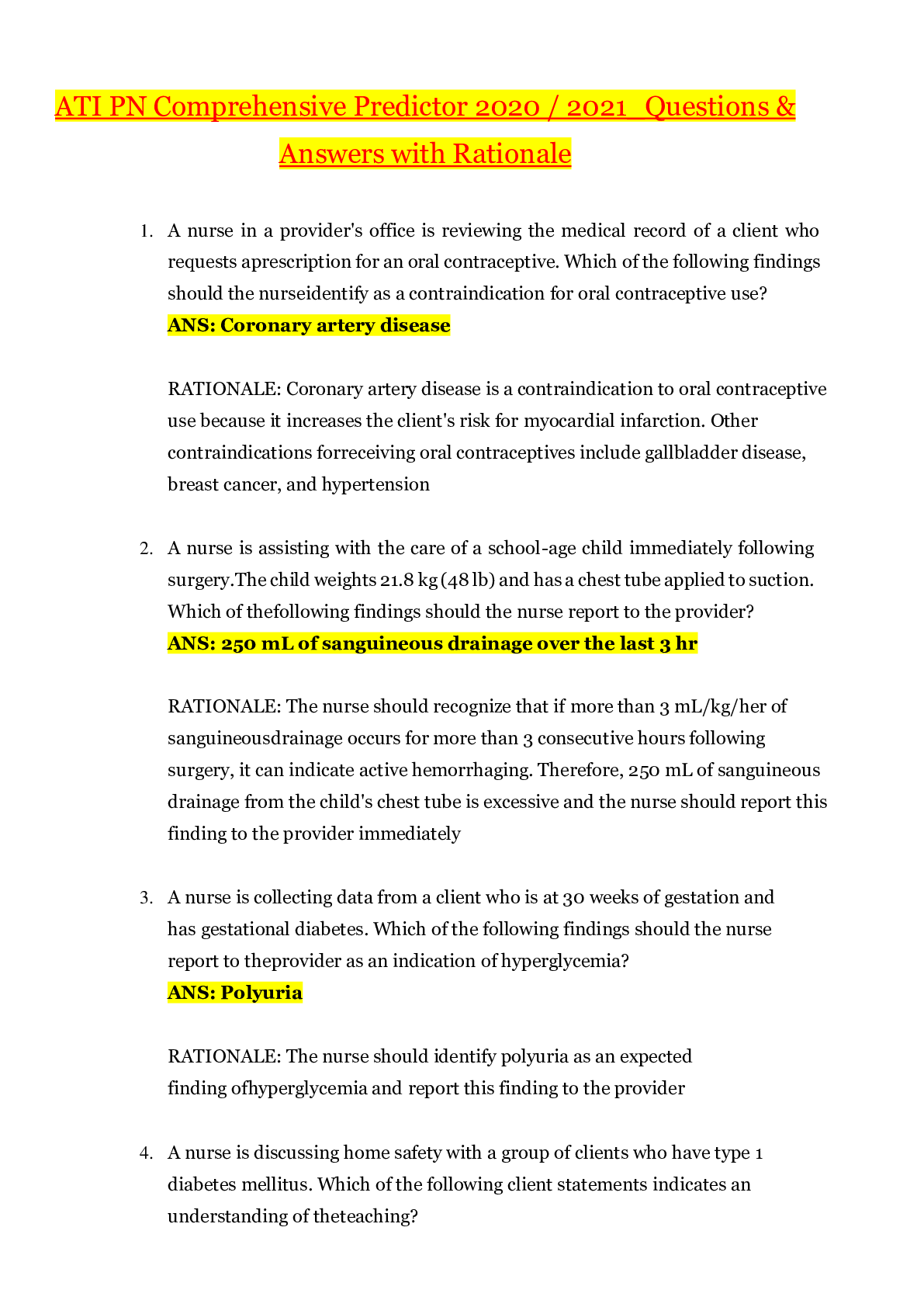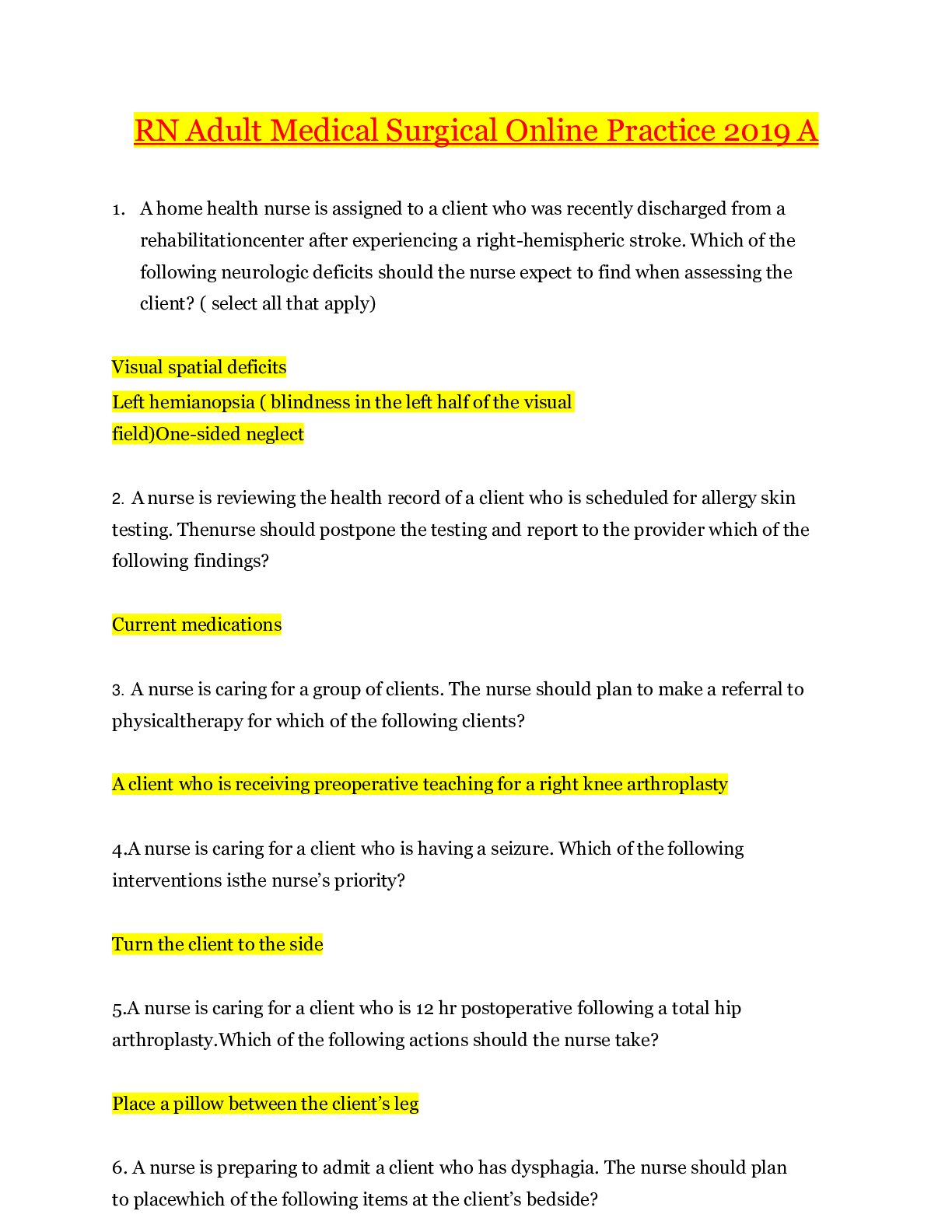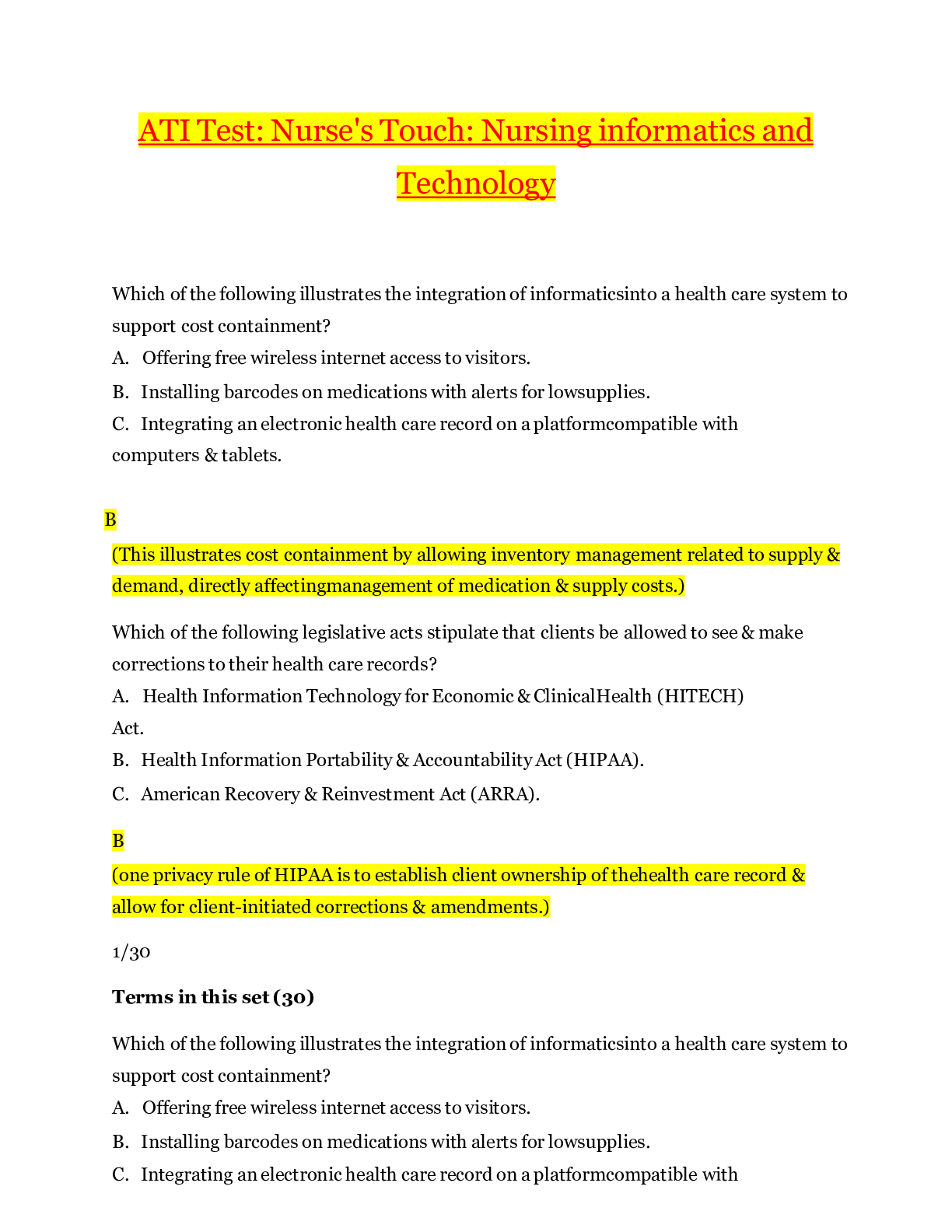*NURSING > QUESTIONS and ANSWERS > NUR 1234 ATI MEDSURG A – Miami Dade College | Med-Surg Practice A (All)
NUR 1234 ATI MEDSURG A – Miami Dade College | Med-Surg Practice A
Document Content and Description Below
NUR 1234 ATI MEDSURG A – Miami Dade College Med-Surg Practice A 1. A nurse has just received a report on a client following a transurethral resection of the prostate (TURP) 12 hr ago. After li... stening to the report in an audio clip, the nurse should identify which of the following as the priority finding? (Your going to have to click to listen) 2. A nurse is caring for a client who has a disposable chest drainage system with a water seal chamber. The nurse is preparing to measure the drainage at the end of the shift. Locate the place where the nurse should mark and measure the drainage for the shift. (You going to have to select the HOTSPOT on picture) 3. A nurse is monitoring a client receiving general anesthesia. The nurse should recognize which of the following as a clinic al manifestation of malignant hyperthermia? 4. A nurse is caring for a client who is 2 hr post-op following a traditional open approach cholecystectomy. Which of the following indicates the need for further nursing assessment? 5. A nurse is caring for a client who is receiving peritoneal dialysis. The client is reporting anorexia and constipation. Which of the following should the nurse include in the client’s plan of care? 6. A nurse is teaching self-care to a client who has a new colostomy. Which of the following is appropriate information to be included in the teaching? 7. A nurse admits an older client to the emergency department with a fractured left wrist following a fall. During the assessment, the client states, “Last week I crashed my car b/c my vision suddenly became blurry.” Which of the following is the highest priority action by the nurse? 8. A nurse is caring for a client who has chronic renal failure. The provider prescribes (Epogen) injections three times per week. Which of the following statements by the client indicates a need for further teaching about the effects of erythropoietin? 9. A client has been receiving propranolol hydrochloride (Inderal) 40 mg PO daily for hypertension. Which of the following indicates that the client is experiencing an adverse reaction to this medication? 10. A nurse on a medical-surgical unit reviews the medical record of an older adult client who is receiving IV fluid therapy. Which of the following client information should indicate to the nurse that the client requires a revision of his IV therapy prescription? 11. A clinic nurse is reviewing laboratory results of four clients. Which of the following clients demonstrates the desired therapeutic effect of the treatment regimen? 12. A client with atrial fibrillation is prescribed digoxin (Lanoxin). Which of the following statements by the client indicates to the nurse that further teaching is needed? 13. A nurse is caring for a client who is receiving total parenteral nutrition. A new bag is not available when the current infusion is nearly completed. Which of the following actions should the nurse take? 14. A client receiving general anesthesia during major surgery has a sudden elevation in temperature. The provider suspects malignant hyperthermia. The nurse should anticipate a prescription foer which of the following medications? 15. A nurse is teaching a client who has a known allergy to bee venom and has a prescription for epinephrine (EpiPen Auto- Injector) how to respond in the event he is stung by a bee. Identify the sequence the client should follow. 16. A nurse is caring for a client who has pneumonia and has been prescribed incentive spirometry. Which of the following findings indicates the desired outcome of this intervention? 17. A nurse in the emergency department is assessing a client who has a history of hypothyroidism. Which of the following assessment findings should indicate to the nurse that the client is at risk for myxedema coma? 18. A nurse is providing discharge instructions to a client who has active tuberculosis (TB). Which of the following should be included in the discharge instructions? 19. A nurse is preparing to perform a 12-lead ECG on a client. Which of the following actions should the nurse plan to take? 20. A nurse is providing teaching to a client who is at risk for developing type 2 diabetes mellitus. The nurse should inform the client that which of the following clinical manifestations indicate diabetes? 21. A nurse is caring for a client who had a gastrectomy 5 days ago. Which of the following interventions will assist in the prevention of dumping syndrome? 22. A nurse is caring for a client who has had a cerebrovascular accident. Which of the following findings indicates that homonymous hemianopsia is present? 23. A nurse is caring for a client who has diabetic ketoacidosis (DKA). Which of the following findings should indicate to the nurse that the client’s condition is improving? 24. A nurse is checking the rhythm strip for a client who has a temporary pacemaker. The nurse notes a spike (pacemaker artifact) Followed by a QRS complex. Which of the following action should the nurse take? 25. When caring for an older adult client with pain, which of the following should the nurse consider regarding pain management? 26. A nurse is planning to provide preoperative teaching for a client who is scheduled for a laparoscopic cholecystectomy tomorrow. Which of the following instructions is the highest priority? 27. A nurse is caring for a client who has a central venous device. Which of the following should the nurse know before performing a complete assessment of the device? 28. An older adult client is brought to the emergency department by a family member. Which of the following assessment findings should cause the nurse to suspect that the client has hypertonic dehydration? 29. A nurse is assigned to care for a client with a spinal cord injury and paraplegia. The client has lost 8lbs in the past 2 weeks & has a low albumin level. Which of the following assessment findings is the highest priority? 30. A nurse is caring for a client who has portal hypertension. The client had vomiting of blood mixed with food after a meal. Which of the following actions should the nurse take first? - - - - - - - - - - - - - - - - - - - - - - - - - - - - - - - - 31. A nurse is providing teaching about exercise for a client who had been diagnosed with osteoarthritis. Which of the following should the nurse include in the teaching? 32. A nurse is providing care for a client who has a spinal cord injury. A halo fixation device is applied to the client’s skull and attached with vertical bars to a padded plastic vest. Which of the following is the priority assessment for the client? 33. A nurse providing teaching to a client who has just been prescribed an oral iron supplement. Which of the following statements by the client indicates an understanding of the teaching? 34. A nurse is planning care for a client who is post-op following renal transplantation. Which of the following is the highest priority nursing intervention to include in the care plan to prevent complications? 35. A nurse is caring for a client with HIV. Which of the following findings indicates a positive response to the prescribed HIV treatment? 36. A nurse is performing pre-op teaching for a client scheduled to have a right modified radical mastectomy. Which of the following should the nurse include in the client’s plan of care? 37. A nurse is caring for a client who is newly diagnoses with hyperthyroidism. Which of the following is the highest priority assessment finding that the nurse should report to the provider? 38. A client presents to the clinic for a 1-week follow-up visit after hospitalization for heart failure. Based on the information in the chart, which of the following findings should the nurse report to the primary care provider? 39. A nurse is preparing a client with supraventricular tachycardia for elective cardioversion. Which of the following prescribed medications should the nurse instruct the client to withhold for 48 hr prior to the cardioversion procedure? 40. A newly licensed nurse is caring for a client diagnosed with MRSA. Which of the following statements by the nurse indicates a need for further teaching? 41. A nurse is assessing a client who has a history of status epilepticus and is having a seizure. Which of the following is the priority assessment? 42. A nurse is assisting a provider with a Tensilon test on a client who was previously diagnosed with myasthenia gravis. After administration of Tensilon, the client demonstrated increased muscle weakness and twitching. The nurse should conclude that the client is exhibiting which of the following conditions? 43. A nurse is planning care for a client who has been admitted with burn injuries and requires immediate subclavian access foe an estimated 32 to 4 weeks. The nurse should include interventions related to the insertion and care of which of the following central venous access devices? (you have to select in the photo) 44. A nurse is caring for a client with a peripherally inserted central catheter (PICC). Which of the following methods of PICC line management is appropriate? 45. A nurse is caring for a client admitted with dehydration. The client’s laboratory values indicate a potassium level of 2.8 mEq/L. IV potassium therapy has been started. Which of the following assessment findings has the highest priority? 46. A nurse is caring for a client receiving heparin for a pulmonary embolism. The nurse should plan to assess the client for which of the following during this treatment? 47. A nurse is caring for a client who is 8hr post-op following total hip arthroplasty. The client is unable to void on the bedpan. Which of the following interventions should the nurse take first? 48. A nurse is providing teaching to a client who has a severe form of stage II Lyme disease. Which of the following statements made by the client reflects understanding of the teaching? 49. A client is in the recovery room following an extracapsular cataract removal. Which of the following findings should the nurse recognize as indicative of a possible complication? [Show More]
Last updated: 2 years ago
Preview 1 out of 15 pages

Buy this document to get the full access instantly
Instant Download Access after purchase
Buy NowInstant download
We Accept:

Reviews( 0 )
$12.50
Can't find what you want? Try our AI powered Search
Document information
Connected school, study & course
About the document
Uploaded On
Sep 21, 2020
Number of pages
15
Written in
Additional information
This document has been written for:
Uploaded
Sep 21, 2020
Downloads
0
Views
78





 – Concorde career College.png)









